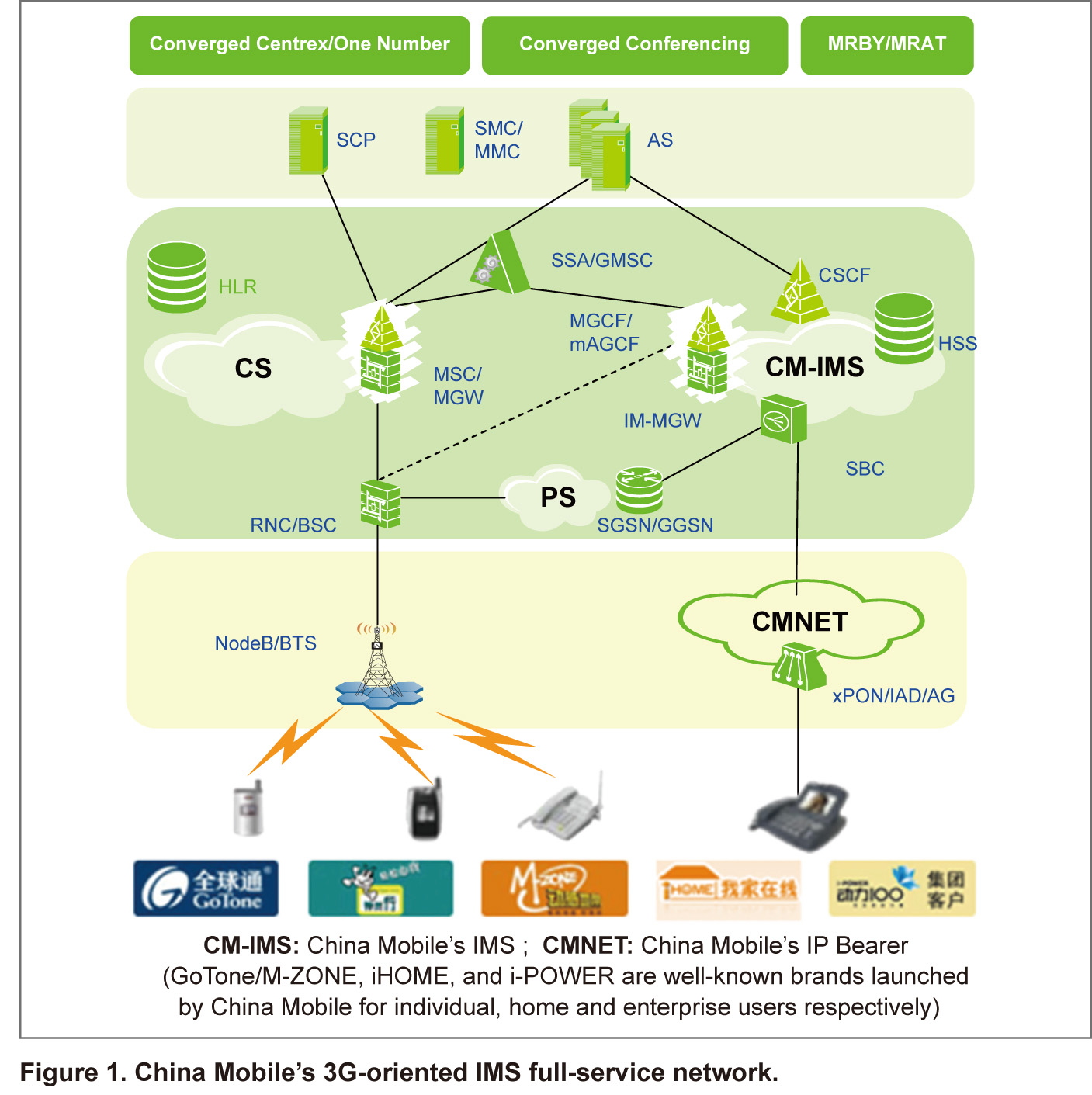China Mobile: Driving Full-Service Operation Through Innovation
As China’s leading mobile operator, China Mobile boasts the largest network and subscriber base in the world. It was granted a fixed network license in 2008, and has since become a full-service operator delivering both fixed-line and mobile services.
Although China Mobile has secured the leading position in China’s mobile business, it falls behind in the home and enterprise user markets due to its lack of fixed network resources and the absence of a mature business brand.
Faced with new competition, China Mobile began to implement full-service operation in four ways: accelerating IP network transformation, expanding wireless coverage, extending optical fiber for transmission between base stations, and deploying an IMS-based network. It now aims to deliver fixed voice and multimedia services to individual and enterprise users over IMS, and finally, to build an IMS-based Fixed and Mobile Convergence (FMC) network.
Initial Step
China Mobile initiated the project of constructing an IMS-based converged office communication network in late 2006, with the view of creating a new business mode for the enterprise user market. Ranking first in comprehensive strength among nine comparable vendors, ZTE was chosen as China Mobile’s exclusive partner to build the network.
After completion, China Mobile’s IMS-based converged office communication network had a subscriber base of over 150,000 and could support more than 60,000 calls and 200 multi-party conferences daily. With abundant customization options, the network offered nearly 300 custom-made services including MMTel, Converged Centrex, Converged One Number, Multimedia Ring Back Tone (MRBT), and Multimedia Conference. Personalized customization at the client level also helped China Mobile form its own business brand “SEECOOL”.
The project successfully demonstrated how IMS could support converged communications, and in this way, China Mobile’s IMS-based business mode for enterprise users was formed.
Further Success
Following the successful application of the IMS-based converged office communication network, China Mobile developed the IMS-based converged High Definition (HD) video conferencing service to meet the needs of modern enterprises for high-definition, large scale conference systems in office communications. The service leverages the benefits of IMS access independence and multimedia service support in order to extend corporate conferences to the Internet and mobile networks. Therefore, users can access conferencing systems anywhere and anytime using their fixed phones, mobile phones, PCs, or professional video conferencing terminals. Furthermore, the conferencing system significantly reduces construction and operation costs as it is integrated into China Mobile’s mature IMS-based converged office communication network, and is managed by the unified IMS-based O&M system.
China Mobile’s IMS-based converged HD video conferencing system is the first of its kind in the industry to be commercially available, covering over 100 nodes in China Mobile Headquarters and in its domestic and overseas branches. Since it was put into operation, the system has been running stably and reliably on the network. It has been successfully used by China Mobile for important conferences such as the Spring Festival mass greet/meeting, long-distance job recruitment, and board meetings. This has greatly enriched the application scenarios of IMS-based converged office communications network.
Innovation-Driven Full-Service Operation
To boost service competitiveness, China Mobile has to leverage its advantages and expand mobile business into the fields of broadband Internet, Customer Premises Network (CPN), and fixed-line VoIP. For this reason, China Mobile actively utilizes IMS to achieve convergence of 3G and full-service networks.
By combining the bandwidth advantage of 3G (TD-SCDMA) wireless data with IMS multimedia service provision capabilities, ZTE helped China Mobile deploy a 3G-oriented IMS full-service network that featured a converged network, terminals, and services (see Figure 1).

■ Network convergence: On September 3, 2009, China Mobile delivered the industry’s first IMS Centralized Services (ICS) call over its 3G-oriented IMS full-service network. A new network element, mAGCF, was introduced that enabled IMS to act as a unified control that could provide multimedia telephony to all users (including users of CS domain) with minimal impact on the existing network. Therefore, users could enjoy seamless service experience without changing their mobile phones.
■ Terminal convergence: China Mobile embedded IMS converged communications software into its 3G mobile phones using the RCS standards. Through the IMS, these mobile phones offer feature-rich 3G value-added services, such as converged messages and video sharing.
■ Service convergence: The network provides mobile and fixed-line subscribers with a seamless FMC experience. For example, Converged One Number supports one phone with many numbers or one number for many phones; Converged Centex enables speed dialing among different types of terminals (mobile/fixed terminal and soft client); and the IMS Converged HD Multimedia Video Conferencing System allows users to access the Internet or mobile networks for the purpose of attending business meetings anytime and anywhere using their fixed phones, mobile phones, PCs, or professional conferencing terminals.
The network offers personalized service portals for individual, home, and enterprise users, and this facilitates layered business management. Operators can open their accounts through the operator portal, while enterprise users can customize their Colorful Ring Back Tone (CRBT) through the enterprise portal.
As a leading IMS provider, ZTE has been the key partner of China Mobile in its IMS implementation. With its comprehensive strength, ZTE will help China Mobile dominate the 3G and full-service market by pushing forward the implementation of IMS full-service strategy.